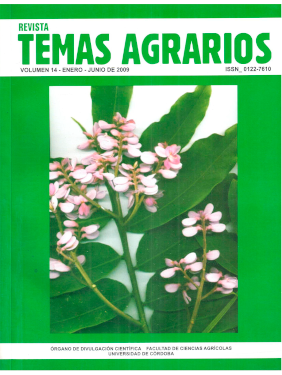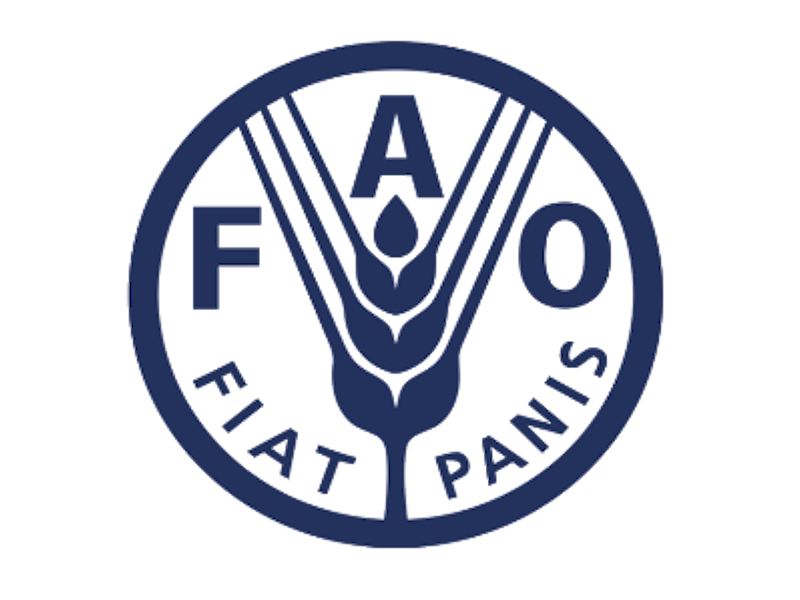Estandarización de la técnica de AFLPS para la caracterización de germoplasma de caña flecha (Gynerium sagittatum Aubl.)
AFLPS technique standarization for arrow cane (Gynerium sagittatum Aubl.) germplasm characterization

Esta obra está bajo una licencia internacional Creative Commons Atribución-NoComercial 4.0.
Mostrar biografía de los autores
La caña flecha (Gynerium sagittatum (Aubl.), especie originaria de la India, constituye la materia prima esencial para la elaboración de artesanías típicas en la Costa Norte Colombiana. Conocer la variabilidad genética de esta especie permite diseñar e implementar estrategias de mejoramiento y conservación de los recursos genéticos. El objetivo del estudio fue desarrollar un protocolo para caracterizar 25 accesiones de caña flecha con AFLPs. El análisis permitió detectar 223 loci que se extendieron desde 43 (E-ACC/M-CAG) hasta 72 loci (E-ACA/M-CTA) con un promedio de 55,75 loci por combinación de iniciadores. La combinación de iniciadores E-ACC/M-CAG generó el mayor porcentaje de polimorfismo (39,53%). Los diferentes perfiles de locus para todos los individuos indicaron un buen escrutinio del genoma para el análisis de la variabilidad y la estructura genética de la especie. El presente protocolo muestra por primera vez la caracterización genética a nivel molecular en caña flecha
Visitas del artículo 716 | Visitas PDF
Descargas
- Aramendiz, H.; Espitia, M. y Robles, J. 2005. Colección, caracterización morfoagronómica y producción de semilla de caña flecha (Gynerium sagittatum AUBL) del Caribe Colombiano. CIUC, Universidad de Córdoba, Montería, p52- 54.
- Ayanogulu, H.; Bayazit, S.; I"nan, G.; Bakir, M.; Akpinar, A.; Kazan, K. y Ergu 1, A. 2007. AFLP analysis of genetic diversity in Turkish green plum accessions (Prunus cerasifera L.) adapted to the Mediterranean region. Scientia Horticulturae 114:263-267.
- Balasaravanan, T.; Pius, P.; Raj Kumar, R.; Muraleedharan, N. y Shasany, A. 2003. Genetic diversity among south Indian tea germplasm (Camellia sinensis, C. assamica and C. assamica spp. lasiocalyx) using AFLP markers. Plant Science 165 365-372.
- Bassam, B.; Caetano Anolles, G. y Gresshoff, P. 1991. Fast and sensitive silver staining of DNA in polyacrylamide gels. Analytical Biochemistry 196(1): 80-83.
- Bentolila, S.; Hardy, T.; Guitton, C. y Freyssinet,G. 1992. Comparative genetic analyses of F2 plants and an ther culture derived plants of maize. Genome 35: 575-582.
- Benin, A.; Ehrich., D. y Manel, S. 2007. Statistical analysis of amplified fragment length polymorphism data: a toolbox for molecular ecologists and evolutionists. Molecular Ecology 16: 3737-3758.
- Chawla, H. 2002. MolecularMarkers and MAS. Introduction to Plant Biotechnology, Science Publishers, Plymouth, p329-358.
- Dice, L. 1945. Measures of the amount of ecological association betweem species. Ecology 26:297-302.
- Ferreira, M.; Satagopan, J.; Yandel, B.; William, P. y Osborn, T. 1995. Genetic mapping of loci controlling vernalization in rapeseed (Brassica napus L.) Theoretical and Applied Genetics 90: 727-732.
- Fregene, M.; Bernal, A.; Duque, M.; Dixon, A.; Tohme M. 2000. AFLP analysis of African cassava (Manihot esculenta Crantz) germplasm resistant to the cassava mosaic disease (CMD). Theoretical and Applied Genetics 100(5):678-685
- Karpa, K.; Bhat K.; Ayad, W. y Hodgkin, T. 1997. MolecularTools in Plant Genetic Resources Conservation: A Guide to the tecnologies. IPGRI Technical Bulletin No. 2. International Plant Genetic Resources Institute, Reme, p107-117.
- Lima, M.; Garcia, A.; Oliveira, S.; Matsuoka, H.; Arizono, C.; De Souza, J. y De Souza, A. 2002. Analysis of genetic similarity detected by AFLP and coeffcient of parentage among genotypes of cane Saccharum spp. Theoretical and Applied Genetics 104:30-38.
- Nei, M. y Li, W. 1979. Mathematical model for studying genetic variation in terms of restriction endonucleases. Proceedings of the National Academy of Sciences 76(10):5269-5273.
- Newbury, H. y Ford-Lloyd, B. 1993. The use of RAPD for assessing variation in plants. PlantGrowth Regulator 12:43-51
- Prashanth, S.; Parani, M.; Mohanty, B.; Talame, V.; Tuberosa, R. and Parida, A. 2002. Genetic diversity in cultivars and landraces of Oryza sativa subsp. indica as revealed by AFLP markers. Genome 45:451-459.
- Phillips, T.; Murphy, J. y Gooman, M. 1993. Isozyme variation in germplasm accessions of the wild oat Avena sterilis L. Theoretical and Applied Genetics 86:54-64.
- QIAGEN. 2004. QIAprep Spin Miniprep Kit.
- http://www1.qiagen.com/products/plasmid/qiaprepminiprepsystem/qiaprepspin miniprepkit.aspx. [Accedido: 08-12- 2008].
- Rohlf, F. (1998). NTSYS-PC, Numerical taxonomy and multivariate analysis system. Version
- 60. Aplied Biostatistics, New York.
- Selvi, A.; Nair, N.; Noyer, J.; Singh, N.; Balasundaram, N.; Bansal, K.; Koundal, K. and Mohapatra, T. 2005. Genomic constitution and genetic relationship among the tropical and subtropical Indian sugarcane cultivars revealed by AFLP. Crop Science 45: 1750-1757.
- Vos, P.; Hogers, R.; Bleeker, M.; Reijans, M.; Van De Lee, T.; Homes, M.; Frijters, A.; Pot, J.; Peleman, J.; Kuiper, M. y Zabeau, M. 1995. AFLP: a new technique for DNA fingerprinting. Nucleic Acids Research. 23:4407-4414.
- Young, N; Zamir, D; Tanksley, S. 1998. Use of isogenic lines and simultaneous probing to identify DNA markers tightly linked to the Tm-2a gene in tomate. Genetics 120:579- 585




















